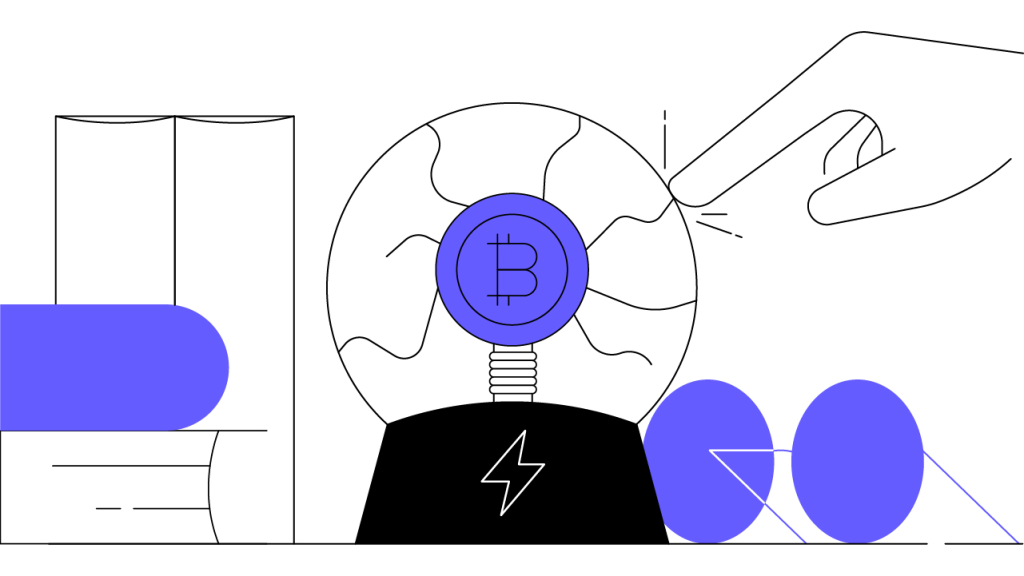Contents
What Is the Lightning Network?
Why Does Bitcoin Need the Lightning Network?
How Does the Lightning Network Work?
What Are the Benefits of the Lightning Network?
What Are the Limitations of Lightning?
Lightning Network Use Cases
What Is the Lightning Network’s Role in Bitcoin’s Growth?
Frequently Asked Questions (FAQs)
The Bottom Line
What Is the Lightning Network & How Does It Work?
The Lightning Network enables instant, low-cost payments with Bitcoin. Learn about how it works and who's already using it.

Summary
changed how we think about money. However, if bitcoin is going to be used like cash, it needs to move faster, cheaper, and more frequently. That’s where the Lightning Network comes in: a protocol built on top of Bitcoin that helps it scale. With Lightning, you can send tiny payments instantly, pay less in fees, and help the Bitcoin network handle more transactions. In this guide, we’ll walk through exactly what the Lightning Network is, how it works, what it’s good for, and why it matters for bitcoin’s future.
changed how we think about money. However, if bitcoin is going to be used like cash, it needs to move faster, cheaper, and more frequently.
That’s where the Lightning Network comes in: a protocol built on top of Bitcoin that helps it scale. With Lightning, you can send tiny payments instantly, pay less in fees, and help the Bitcoin network handle more transactions.
In this guide, we’ll walk through exactly what the Lightning Network is, how it works, what it’s good for, and why it matters for bitcoin’s future.
What Is the Lightning Network?
The is a "Layer 2" payment protocol that sits on top of the Bitcoin blockchain. It was designed to solve one of Bitcoin’s biggest challenges: scalability. On its own, the Bitcoin network can only handle around 7 transactions per second. That’s nowhere near enough volume for widespread use.
. Within these channels, they can send unlimited transactions without burdening the main blockchain. Only two events get recorded on the Bitcoin blockchain: the channel opening and the channel closing.
This setup significantly reduces congestion on the network, lowers transaction fees, and speeds up payment times. Lightning brings bitcoin one step closer to being used for everyday purchases, like buying a coffee or tipping a content creator. It transforms bitcoin from a store of value to a functional medium of exchange, ideal for digital payments.
Why Does Bitcoin Need the Lightning Network?
While bitcoin is safe and not controlled by one government, it’s not well-suited for fast transactions.
If there is a lot of activity on the network, both confirmations and fees can become much slower. This works well for big money transfers or keeping your funds for a long time, but it’s not the most efficient when you need to buy something instantly.
Thanks to the Lightning Network, those small and regular payments get made outside the main blockchain.
With Lightning, you can:
Send microtransactions instantly
Pay tiny fees (fractions of a cent)
Reduce congestion on the main network
Help the Bitcoin network scale and have more
This is especially important as bitcoin gains more attention globally. , the network could become too costly or slow for widespread adoption.
How Does the Lightning Network Work?
Let’s break it down step by step:
1. Opening a Payment Channel
Two people agree to open a Lightning channel. They each deposit bitcoin into a shared wallet (a multi-signature address), which gets recorded on the blockchain. This initial transaction ensures both parties have skin in the game and secures the funds within the channel.
2. Transacting Off-Chain
Within that channel, they can send unlimited payments to each other instantly and with minimal fees.
Each transaction updates the balance sheet between them, but nothing is broadcast to the blockchain until the channel is closed. This approach reduces the need for network confirmation and significantly cuts costs.
3. Routing Through the Network
If you’re not directly connected to someone, the Lightning Network can route your payment through other users. It finds a path through connected channels, like hopping from friend to friend until the payment reaches its destination. Each hop deducts a tiny fee, but the payment remains fast and secure.
This dynamic routing system makes Lightning incredibly flexible. You don’t need to know or connect directly with the recipient — just connect to the network.
4. Closing the Channel
When the participants are done transacting, they close the channel. The final balance is broadcast to the Bitcoin network, and the funds are updated accordingly. This final on-chain transaction confirms how much each person receives based on their off-chain interactions.
This system allows faster, more scalable transactions while keeping the Bitcoin blockchain secure and decentralized.
What Are the Benefits of the Lightning Network?
Why are so many Bitcoin advocates excited about Lightning? Here’s what it brings to the table:
Speed: Payments are instant, without waiting for blockchain confirmations. This means users can send bitcoin as quickly as they would send a text.
Low Fees: You can send tiny amounts of bitcoin for a fraction of a cent. This makes Lightning ideal for tipping, streaming payments, and other small-scale transactions.
Scalability: Millions of transactions per second are possible across the network, which allows .
Privacy: Only opening and closing transactions are recorded on-chain, improving user privacy. Transactions within the channel remain off-chain and unseen.
New Use Cases: Stream money, tip creators, or use bitcoin in video games in real time. These innovations allow for more interactive and creative financial experiences.
As user demand for fast and cheap digital payments grows, Lightning positions Bitcoin to meet that demand while staying decentralized.
What Are the Limitations of Lightning?
As promising as Lightning is, it’s not without its issues:
Liquidity Constraints: You can’t send more bitcoin than what’s available in your channel.
Technical Barriers: Setting up a Lightning node or managing channels can still be intimidating.
Routing Problems: The payment might fail if there isn’t a good path between two users.
Always-On Requirement: Your device or wallet often needs to stay online to receive payments.
Developers are addressing these challenges by building more user-friendly Lightning wallets, automated liquidity solutions, and stronger routing protocols.
Unlock the future of money on Gemini
Start your crypto journey in minutes on the trusted crypto-native finance platform
Lightning Network Use Cases
So, who’s using the Lightning Network today?
El Salvador: Citizens use Lightning to pay for food, gas, and services thanks to adoption of a national bitcoin reserve. Many street vendors and shops accept bitcoin through Lightning-powered wallets.
Strike: A popular app that uses Lightning for international remittances with almost no fees. It allows users to send money across borders instantly and cheaply.
Twitter (X): Integrated Lightning for bitcoin tipping. Users can support content creators with micro-tips directly on the platform.
Gaming: Games now reward players in real-time using Lightning-based microtransactions. Platforms like Zebedee are integrating Lightning to offer real-world value for in-game achievements.
Merchants and Retailers: Some online and brick-and-mortar stores accept Lightning payments to avoid credit card fees and delays. This includes cafes, e-commerce shops, and even travel websites.
Content Platforms and Streamers: Podcasters, video creators, and writers are using Lightning to receive direct tips and stream payments without intermediaries.
From mobile apps to grassroots economic empowerment, Lightning is proving to be a working solution for real problems across diverse industries.
What Is the Lightning Network’s Role in Bitcoin’s Growth?
Bitcoin was built to be secure and decentralized, not to work fast. Still, due to the Lightning Network and similar solutions, it doesn’t have to slow down to preserve those core principles.
Because of the transaction efficiencies and low costs, Lightning invites more people to make everyday transactions with bitcoin. Whether you want to pay for food, move your money overseas, or reward a favorite creator, Lightning makes it easy.
This helps Bitcoin become more available to everyone, handle greater transactions, and be useful everywhere.
Frequently Asked Questions (FAQs)
Is the Lightning Network safe?
Yes. It’s built on Bitcoin’s existing security model, using smart contracts to ensure trustless payments.
Does the Lightning Network use Bitcoin?
Yes. Lightning uses real bitcoin to settle transactions.
Can anyone use the Lightning Network?
Yes. There are wallets and apps that make it easy for anyone to get started with Lightning, no technical background needed.
What are Lightning nodes?
Nodes are participants in the Lightning Network that help route transactions between users. Anyone can run one.
Is the Lightning Network free to use?
The Lightning Network is not entirely free, but fees are extremely low, often just a few sats (fractions of a cent).
The Bottom Line
Bitcoin’s potential has always been bigger than slow, expensive transactions. The Lightning Network helps unlock that potential by making Bitcoin fast, cheap, and usable at scale.
With real-world adoption growing and new tools making it easier to use, Lightning is helping bitcoin move from investment asset to everyday money.
Want to experience fast, secure crypto payments? Explore the Bitcoin network and the Lightning Network with confidence and get started on today.

Author
Is this article helpful?
